The Highly Uniform Photoresponsivity from Visible to Near IR Light in Sb2Te3 Flakes
Abstract
1. Introduction
2. Materials and Methods
3. Results and Discussion
4. Conclusions
Author Contributions
Funding
Institutional Review Board Statement
Informed Consent Statement
Data Availability Statement
Conflicts of Interest
Appendix A
Appendix B
Appendix C
References
- Chen, C.; Qiao, H.; Lin, S.; Man Luk, C.; Liu, Y.; Xu, Z.; Song, J.; Xue, Y.; Li, D.; Yuan, J.; et al. Highly responsive MoS2 photodetectors enhanced by graphene quantum dots. Sci. Rep. 2015, 5, 11830. [Google Scholar] [CrossRef] [PubMed]
- Chen, R.S.; Wang, W.C.; Chan, C.H.; Lu, M.L.; Chen, Y.F.; Lin, H.C.; Chen, K.H.; Chen, L.C. Photoconduction efficiencies of metal oxide semiconductor nanowires: The material’s inherent properties. Appl. Phys. Lett. 2013, 103, 223107. [Google Scholar] [CrossRef]
- Konstantatos, G.; Badioli, M.; Gaudreau, L.; Osmond, J.; Bernechea, M.; de Arquer, F.P.G.; Gatti, F.; Koppens, F.H.L. Hybrid graphene–quantum dot phototransistors with ultrahigh gain. Nat. Nanotechnol. 2012, 7, 363–368. [Google Scholar] [CrossRef]
- Roy, K.; Padmanabhan, M.; Goswami, S.; Sai, T.P.; Ramalingam, G.; Raghavan, S.; Ghosh, A. Graphene–MoS2 hybrid structures for multifunctional photoresponsive memory devices. Nat. Nanotechnol. 2013, 8, 826–830. [Google Scholar] [CrossRef] [PubMed]
- Soci, C.; Zhang, A.; Xiang, B.; Dayeh, S.A.; Aplin, D.P.R.; Park, J.; Bao, X.Y.; Lo, Y.H.; Wang, D. ZnO Nanowire UV Photodetectors with High Internal Gain. Nano Lett. 2007, 7, 1003–1009. [Google Scholar] [CrossRef]
- Zhang, W.; Chuu, C.-P.; Huang, J.-K.; Chen, C.-H.; Tsai, M.-L.; Chang, Y.-H.; Liang, C.-T.; Chen, Y.-Z.; Chueh, Y.-L.; He, J.-H.; et al. Ultrahigh-Gain Photodetectors Based on Atomically Thin Graphene- MoS2 Heterostructures. Sci. Rep. 2014, 4, 3826. [Google Scholar] [CrossRef]
- Zhang, B.Y.; Liu, T.; Meng, B.; Li, X.; Liang, G.; Hu, X.; Wang, Q.J. Broadband high photoresponse from pure monolayer graphene photodetector. Nat. Commun. 2013, 4, 1811. [Google Scholar] [CrossRef]
- Mueller, T.; Xia, F.; Avouris, P. Graphene photodetectors for high-speed optical communications. Nat. Photonics 2010, 4, 297–301. [Google Scholar] [CrossRef]
- Hu, P.; Wen, Z.; Wang, L.; Tan, P.; Xiao, K. Synthesis of Few-Layer GaSe Nanosheets for High Performance Photodetectors. ACS Nano 2012, 6, 5988–5994. [Google Scholar] [CrossRef]
- Hu, P.; Wang, L.; Yoon, M.; Zhang, J.; Feng, W.; Wang, X.; Wen, Z.; Idrobo, J.C.; Miyamoto, Y.; Geohegan, D.B.; et al. Highly Responsive Ultrathin GaS Nanosheet Photodetectors on Rigid and Flexible Substrates. Nano Lett. 2013, 13, 1649–1654. [Google Scholar] [CrossRef]
- Yin, Z.; Li, H.; Li, H.; Jiang, L.; Shi, Y.; Sun, Y.; Lu, G.; Zhang, Q.; Chen, X.; Zhang, H. Single-Layer MoS2 Phototransistors. ACS Nano 2012, 6, 74–80. [Google Scholar] [CrossRef] [PubMed]
- Furchi, M.M.; Polyushkin, D.K.; Pospischil, A.; Mueller, T. Mechanisms of Photoconductivity in Atomically Thin MoS2. Nano Lett. 2014, 14, 6165–6170. [Google Scholar] [CrossRef] [PubMed]
- Tsai, D.-S.; Liu, K.-K.; Lien, D.-H.; Tsai, M.-L.; Kang, C.-F.; Lin, C.-A.; Li, L.-J.; He, J.-H. Few-Layer MoS2 with High Broadband Photogain and Fast Optical Switching for Use in Harsh Environments. ACS Nano 2013, 7, 3905–3911. [Google Scholar] [CrossRef]
- Zhang, W.; Huang, J.-K.; Chen, C.-H.; Chang, Y.-H.; Cheng, Y.-J.; Li, L.-J. High-Gain Phototransistors Based on a CVD MoS2 Monolayer. Adv. Mater. 2013, 25, 3456–3461. [Google Scholar] [CrossRef]
- Choi, W.; Cho, M.Y.; Konar, A.; Lee, J.H.; Cha, G.-B.; Hong, S.C.; Kim, S.; Kim, J.; Jena, D.; Joo, J.; et al. High-Detectivity Multilayer MoS2 Phototransistors with Spectral Response from Ultraviolet to Infrared. Adv. Mater. 2012, 24, 5832–5836. [Google Scholar] [CrossRef] [PubMed]
- Buscema, M.; Island, J.O.; Groenendijk, D.J.; Blanter, S.I.; Steele, G.A.; van der Zant, H.S.J.; Castellanos-Gomez, A. Photocurrent generation with two-dimensional van der Waals semiconductors. Chem. Soc. Rev. 2015, 44, 3691–3718. [Google Scholar] [CrossRef] [PubMed]
- Lv, Q.; Lv, R. Two-Dimensional Heterostructures Based on Graphene and Transition Metal Dichalcogenides: Synthesis, Transfer and Applications. Carbon 2019, 145, 240–250. [Google Scholar] [CrossRef]
- Passmore, B.S.; Wu, J.; Manasreh, M.O.; Salamo, G.J. Dual broadband photodetector based on interband and intersubband transitions in InAs quantum dots embedded in graded InGaAs quantum wells. Appl. Phys. Lett. 2007, 91, 233508. [Google Scholar] [CrossRef]
- Yu, X.-X.; Wang, Y.; Zhang, H.; Zhu, D.; Xiong, Y.; Zhang, W. Fabrication of a Cost Effective and Broadband Self-Powered Photodetector Based on Sb2Te3 and Silicon. Nanotechnology 2019, 30, 345202. [Google Scholar] [CrossRef] [PubMed]
- Chander, S.; Purohit, A.; Nehra, A.; Nehra, S.P.; Dhaka, M.S. A Study on Spectral Response and External Quantum Efficiency of Mono-Crystalline Silicon Solar Cell. Int. J. Renew. Energy Res. 2015, 5, 41–44. [Google Scholar]
- Lei, S.; Ge, L.; Najmaei, S.; George, A.; Kappera, R.; Lou, J.; Chhowalla, M.; Yamaguchi, H.; Gupta, G.; Vajtai, R.; et al. Evolution of the Electronic Band Structure and Efficient Photo-Detection in Atomic Layers of InSe. ACS Nano 2014, 8, 1263–1272. [Google Scholar] [CrossRef]
- Yang, Z.; Jie, W.; Mak, C.-H.; Lin, S.; Lin, H.; Yang, X.; Yan, F.; Lau, S.P.; Hao, J. Wafer-Scale Synthesis of High-Quality Semiconducting Two-Dimensional Layered InSe with Broadband Photoresponse. ACS Nano 2017, 11, 4225–4236. [Google Scholar] [CrossRef]
- Feng, W.; Gao, F.; Hu, Y.; Dai, M.; Li, H.; Wang, L.; Hu, P. High-performance and flexible photodetectors based on chemical vapor deposition grown two-dimensional In2Se3 nanosheets. Nanotechnology 2018, 29, 445205. [Google Scholar] [CrossRef] [PubMed]
- Mech, R.K.; Solanke, S.V.; Mohta, N.; Rangarajan, M.; Nath, D.N. In2Se3 Visible/Near-IR Photodetector With Observation of Band-Edge in Spectral Response. IEEE Photonics Technol. Lett. 2019, 31, 905–908. [Google Scholar] [CrossRef]
- Long, M.; Gao, A.; Wang, P.; Xia, H.; Ott, C.; Pan, C.; Fu, Y.; Liu, E.; Chen, X.; Lu, W.; et al. Room temperature high-detectivity mid-infrared photodetectors based on black arsenic phosphorus. Sci. Adv. 2017, 3, e1700589. [Google Scholar] [CrossRef] [PubMed]
- Wu, J.; Koon, G.K.W.; Xiang, D.; Han, C.; Toh, C.T.; Kulkarni, E.S.; Verzhbitskiy, I.; Carvalho, A.; Rodin, A.S.; Koenig, S.P.; et al. Colossal Ultraviolet Photoresponsivity of Few-Layer Black Phosphorus. ACS Nano 2015, 9, 8070–8077. [Google Scholar] [CrossRef]
- Buscema, M.; Groenendijk, D.J.; Blanter, S.I.; Steele, G.A.; van der Zant, H.S.J.; Castellanos-Gomez, A. Fast and Broadband Photoresponse of Few-Layer Black Phosphorus Field-Effect Transistors. Nano Lett. 2014, 14, 3347–3352. [Google Scholar] [CrossRef]
- Patel, A.B.; Chauhan, P.; Machhi, H.K.; Narayan, S.; Sumesh, C.K.; Patel, K.D.; Soni, S.S.; Jha, P.K.; Solanki, G.K.; Pathak, V.M. Transferrable thin film of ultrasonically exfoliated MoSe2 nanocrystals for efficient visible-light photodetector. Phys. E Low-dimensional Syst. 2020, 119, 114019. [Google Scholar] [CrossRef]
- Zhang, W.; Chiu, M.-H.; Chen, C.-H.; Chen, W.; Li, L.-J.; Wee, A.T.S. Role of Metal Contacts in High-Performance Phototransistors Based on WSe2 Monolayers. ACS Nano 2014, 8, 8653–8661. [Google Scholar] [CrossRef]
- Pataniya, P.; Zankat, C.K.; Tannarana, M.; Sumesh, C.K.; Narayan, S.; Solanki, G.K.; Patel, K.D.; Pathak, V.M.; Jha, P.K. Paper-Based Flexible Photodetector Functionalized by WSe2 Nanodots. ACS Appl. Nano Mater. 2019, 2, 2758–2766. [Google Scholar] [CrossRef]
- Perea-López, N.; Elías, A.L.; Berkdemir, A.; Castro-Beltran, A.; Gutiérrez, H.R.; Feng, S.; Lv, R.; Hayashi, T.; López-Urías, F.; Ghosh, S.; et al. Photosensor Device Based on Few-Layered WS2 Films. Adv. Funct. Mater. 2013, 23, 5511–5517. [Google Scholar] [CrossRef]
- Lopez-Sanchez, O.; Lembke, D.; Kayci, M.; Radenovic, A.; Kis, A. Ultrasensitive photodetectors based on monolayer MoS2. Nat. Nanotechnol. 2013, 8, 497–501. [Google Scholar] [CrossRef] [PubMed]
- Yu, X.; Yu, P.; Wu, D.; Singh, B.; Zeng, Q.; Lin, H.; Zhou, W.; Lin, J.; Suenaga, K.; Liu, Z.; et al. Atomically thin noble metal dichalcogenide: A broadband mid-infrared semiconductor. Nat. Commun. 2018, 9, 1545. [Google Scholar] [CrossRef]
- Tao, Y.; Wu, X.; Wang, W.; Wang, J. Flexible photodetector from ultraviolet to near infrared based on a SnS2 nanosheet microsphere film. J. Mater. Chem. C 2015, 3, 1347–1353. [Google Scholar] [CrossRef]
- Zhou, X.; Gan, L.; Tian, W.; Zhang, Q.; Jin, S.; Li, H.; Bando, Y.; Golberg, D.; Zhai, T. Ultrathin SnSe2 Flakes Grown by Chemical Vapor Deposition for High-Performance Photodetectors. Adv. Mater. 2015, 27, 8035–8041. [Google Scholar] [CrossRef] [PubMed]
- Ogawa, S.; Shimatani, M.; Fukushima, S.; Okuda, S.; Kanai, Y.; Ono, T.; Matsumoto, K. Broadband photoresponse of graphene photodetector from visible to long-wavelength infrared wavelengths. Opt. Eng. 2019, 58, 057106. [Google Scholar] [CrossRef]
- Unsuree, N.; Selvi, H.; Crabb, M.G.; Alanis, J.A.; Parkinson, P.; Echtermeyer, T.J. Visible and infrared photocurrent enhancement in a graphene-silicon Schottky photodetector through surface-states and electric field engineering. 2D Mater. 2019, 6, 041004. [Google Scholar] [CrossRef]
- Sorifi, S.; Moun, M.; Kaushik, S.; Singh, R. High-Temperature Performance of a GaSe Nanosheet-Based Broadband Photodetector. ACS Appl. Electron. Mater. 2020, 2, 670–676. [Google Scholar] [CrossRef]
- Cao, Y.; Cai, K.; Hu, P.; Zhao, L.; Yan, T.; Luo, W.; Zhang, X.; Wu, X.; Wang, K.; Zheng, H. Strong enhancement of photoresponsivity with shrinking the electrodes spacing in few layer GaSe photodetectors. Sci. Rep. 2015, 5, 8130. [Google Scholar] [CrossRef]
- Liang, F.; Wang, C.; Luo, C.; Xia, Y.; Wang, Y.; Xu, M.; Wang, H.; Wang, T.; Zhu, Y.; Wu, P.; et al. Ferromagnetic CoSe broadband photodetector at room temperature. Nanotechnology 2020, 31, 374002. [Google Scholar] [CrossRef] [PubMed]
- Lee, J.W.; Kim, D.Y.; Baek, S.; Yu, H.; So, F. Inorganic UV–Visible–SWIR Broadband Photodetector Based on Monodisperse PbS Nanocrystals. Small 2016, 12, 1328–1333. [Google Scholar] [CrossRef]
- Chen, S.; Shehzad, K.; Qiao, X.; Luo, X.; Liu, X.; Zhang, Y.; Zhang, X.; Xu, Y.; Fan, X. A high performance broadband photodetector based on (SnxSb1−x)Se3 nanorods with enhanced electrical conductivity. J. Mater. Chem. C 2018, 6, 11078–11085. [Google Scholar] [CrossRef]
- Hasan, M.R.; Arinze, E.S.; Singh, A.K.; Oleshko, V.P.; Guo, S.; Rani, A.; Cheng, Y.; Kalish, I.; Zaghloul, M.E.; Rao, M.V.; et al. An Antimony Selenide Molecular Ink for Flexible Broadband Photodetectors. Adv. Electron. Mater. 2016, 2, 1600182. [Google Scholar] [CrossRef]
- Wang, Z.; Safdar, M.; Jiang, C.; He, J. High-Performance UV–Visible–NIR Broad Spectral Photodetectors Based on One-Dimensional In2Te3 Nanostructures. Nano Lett. 2012, 12, 4715–4721. [Google Scholar] [CrossRef]
- Yan, S.; Zhou, L.; Shi, Y.; Wang, B.; Wang, J.; Xu, X. Solvothermal Synthesis of Indium Telluride Nanowires and Its Photoelectrical Property. J. Nanosci. Nanotechnol. 2015, 15. [Google Scholar] [CrossRef] [PubMed]
- Jiang, T.; Zang, Y.; Sun, H.; Zheng, X.; Liu, Y.; Gong, Y.; Fang, L.; Cheng, X.; He, K. Broadband High-Responsivity Photodetectors Based on Large-Scale Topological Crystalline Insulator SnTe Ultrathin Film Grown by Molecular Beam Epitaxy. Adv. Opt. Mater. 2017, 5, 1600727. [Google Scholar] [CrossRef]
- Yang, J.; Yu, W.; Pan, Z.; Yu, Q.; Yin, Q.; Guo, L.; Zhao, Y.; Sun, T.; Bao, Q.; Zhang, K. Ultra-Broadband Flexible Photodetector Based on Topological Crystalline Insulator SnTe with High Responsivity. Small 2018, 14, 1802598. [Google Scholar] [CrossRef] [PubMed]
- Wang, Q.; Li, C.-Z.; Ge, S.; Li, J.-G.; Lu, W.; Lai, J.; Liu, X.; Ma, J.; Yu, D.-P.; Liao, Z.-M.; et al. Ultrafast Broadband Photodetectors Based on Three-Dimensional Dirac Semimetal Cd3As2. Nano Lett. 2017, 17, 834–841. [Google Scholar] [CrossRef]
- Niu, Y.; Wang, B.; Chen, J.; Wu, D. Ultra-broadband and highly responsive photodetectors based on a novel EuBiTe3 flake material at room temperature. J. Mater. Chem. C 2018, 6, 713–716. [Google Scholar] [CrossRef]
- Zhang, H.; Zhang, X.; Liu, C.; Lee, S.-T.; Jie, J. High-Responsivity, High-Detectivity, Ultrafast Topological Insulator Bi2Se3/Silicon Heterostructure Broadband Photodetectors. ACS Nano 2016, 10, 5113–5122. [Google Scholar] [CrossRef]
- Jian, H.-L. Investigation of Crystal Properties of Topological Insulator Bi(x)Sb(2−X)Te3 by Melting Growth Method. Master’s Thesis, National Sun Yat-Sen University, Kaohsiung, Taiwan, 4 September 2018. [Google Scholar]
- Shahil, K.M.F.; Hossain, M.Z.; Goyal, V.; Balandin, A.A. Micro-Raman Spectroscopy of Mechanically Exfoliated Few-Quintuple Layers of Bi2Te3, Bi2Se3, and Sb2Te3 Materials. J. Appl. Phys. 2012, 111, 054305. [Google Scholar] [CrossRef]
- Zybala, R.; Mars, K.; Mikuła, A.; Boguslawski, J.; Sobon, G.; Sotor, J.; Schmidt, M.; Kaszyca, K.; Chmielewski, M.; Ciupinski, L.; et al. Synthesis and Characterization of Antimony Telluride for Thermoelectric and Optoelectronic Applications. Arch. Metall. Mater. 2017, 62. [Google Scholar] [CrossRef]
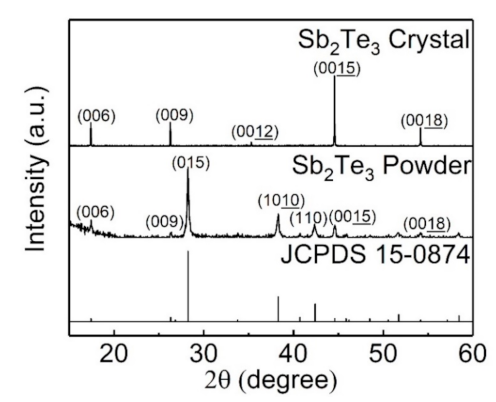
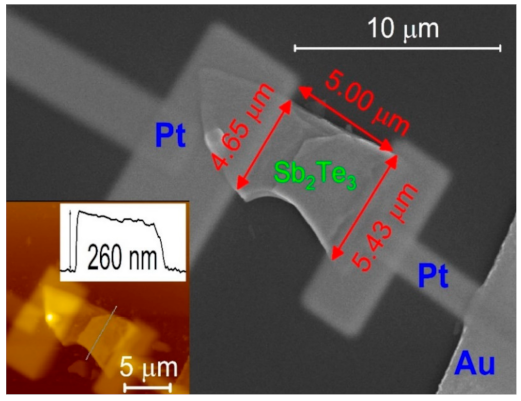

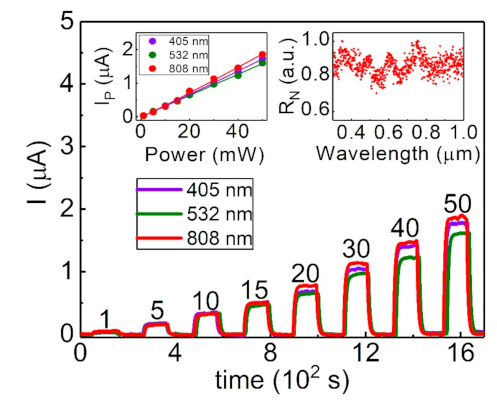
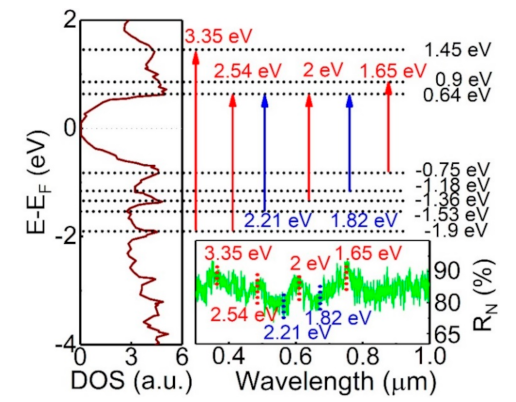
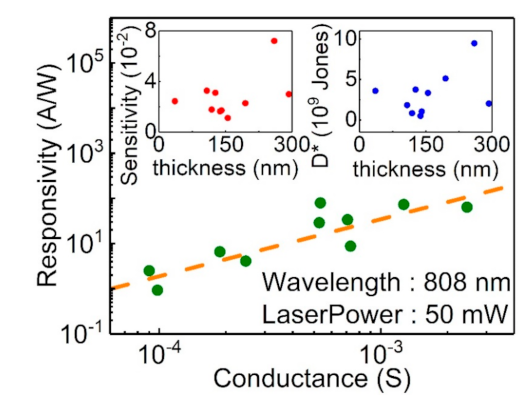
| Laser Wavelength | 405 (nm) | 532 (nm) | 808 (nm) |
|---|---|---|---|
| 38 | 31 | 43 | |
| 1.03 | 0.99 | 1.05 |
| Material | Wavelength (nm) | Deviation Ratio (%) | Reference |
|---|---|---|---|
| Sb2Te3 | 300∼1000 | 34 | This work |
| Sb2Te3/Si/Sb2Te3 | 365∼940 | 98.17 | [19] |
| Si | 350∼1050 | 109.41 | [20] |
| InSe | 400∼800 | 180 | [21] |
| InSe | 370∼980 | 266 | [22] |
| In2Se3 | 250∼700 | 252 | [23] |
| In2Se3 | 400∼900 | 104 | [24] |
| AsP | 2500∼8000 | 121 | [25] |
| BP | 300∼680 | 2449 | [26] |
| BP | 405∼940 | 156 | [27] |
| MoSe2 | 400∼600 | 87 | [28] |
| WSe2 | 500∼800 | 217 | [29] |
| WSe2 | 390∼880 | 70 | [30] |
| WS2 | 450∼650 | 235 | [31] |
| MoS2 | 400∼690 | 542 | [32] |
| MoS2 | 455∼850 | 178 | [15] |
| PtSe2 | 2500∼10,000 | 373 | [33] |
| SnS2 | 300∼700 | 130 | [34] |
| SnSe2 | 500∼700 | 286 | [35] |
| Graphene | 600∼9600 | 7334 | [36] |
| Graphene | 1100∼1650 | 1443 | [37] |
| GaSe | 220∼650 | 165 | [38] |
| GaSe | 400∼800 | 368 | [39] |
| GaS | 245∼610 | 278 | [10] |
| CoSe | 450∼4100 | 143 | [40] |
| CoSe | 450∼950 | 132 | [40] |
| PbS | 400∼2000 | 186 | [41] |
| InGaAs | 400∼16,000 | 397 | [18] |
| InGaAs | 400∼1000 | 220 | [18] |
| Sb2Se3 | 300∼1100 | 267 | [42] |
| Sb2Se3 | 300∼1100 | 226 | [43] |
| In2Te3 | 350∼1090 | 129 | [44] |
| In2Te3 | 350∼1000 | 403 | [45] |
| SnTe | 405∼2003 | 120 | [46] |
| SnTe | 405∼808 | 91 | [46] |
| SnTe | 254∼650 | 399 | [47] |
| Cd3As2 | 532∼10,600 | 926 | [48] |
| Cd3As2 | 532∼940 | 140 | [48] |
| EuBiTe3 | 370∼1550 | 112 | [49] |
| EuBiTe3 | 370∼1064 | 110 | [49] |
Publisher’s Note: MDPI stays neutral with regard to jurisdictional claims in published maps and institutional affiliations. |
© 2021 by the authors. Licensee MDPI, Basel, Switzerland. This article is an open access article distributed under the terms and conditions of the Creative Commons Attribution (CC BY) license (http://creativecommons.org/licenses/by/4.0/).
Share and Cite
Huang, S.-M.; Hung, J.-L.; Chou, M.; Chen, C.-Y.; Liu, F.-C.; Chen, R.-S. The Highly Uniform Photoresponsivity from Visible to Near IR Light in Sb2Te3 Flakes. Sensors 2021, 21, 1535. https://doi.org/10.3390/s21041535
Huang S-M, Hung J-L, Chou M, Chen C-Y, Liu F-C, Chen R-S. The Highly Uniform Photoresponsivity from Visible to Near IR Light in Sb2Te3 Flakes. Sensors. 2021; 21(4):1535. https://doi.org/10.3390/s21041535
Chicago/Turabian StyleHuang, Shiu-Ming, Jai-Lung Hung, Mitch Chou, Chi-Yang Chen, Fang-Chen Liu, and Ruei-San Chen. 2021. "The Highly Uniform Photoresponsivity from Visible to Near IR Light in Sb2Te3 Flakes" Sensors 21, no. 4: 1535. https://doi.org/10.3390/s21041535
APA StyleHuang, S.-M., Hung, J.-L., Chou, M., Chen, C.-Y., Liu, F.-C., & Chen, R.-S. (2021). The Highly Uniform Photoresponsivity from Visible to Near IR Light in Sb2Te3 Flakes. Sensors, 21(4), 1535. https://doi.org/10.3390/s21041535






